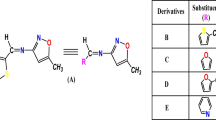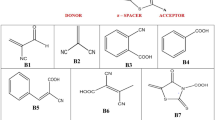Abstract
In this work, we studied the structural, optical, nonlinear optical properties , absorption spectra and phosphorescence properties of four cyclometalated heteroleptic iridium complexes [Ir(dFNppy)2(PPh3)L] with dFNppy = 5-nitro-2-(2′,4′-difluorophenylpyridyl, PPh3 = triphenylphosphine, L = Cl− (1), NCS− (2), NCO− (3) and N3− (4) using DFT and TD-DFT methods. The electronic and geometrical structures of the S0 and T1 have been studied and compared. Experimental absorption bands were assigned on the basis of natural transition orbitales, and a good agreement with experience has been obtained. Phosphorescence wavelengths of the four complexes were calculated with vertical and adiabatic methods. Further, linear optical properties (mean polarizability \(\left\langle \alpha \right\rangle\), anisotropy polarizability \(\left| \alpha \right|\)), the static first hyperpolarizabilities electric-field-induced second harmonic generation \(\beta_{//} \left( { - 2\omega ;\omega ,\omega } \right)\) and the hyper-Rayleigh scattering (HRS) first hyperpolarizability \(\beta_{\text{HRS}} \left( { - 2\omega ;\omega ,\omega } \right)\)), and the depolarization ratio DR of these complexes are calculated by DFT with PBE0 functional in order to understand nonlinear optical properties. Higher polarizability \((\alpha )\) and first hyperpolarizabilities \((\beta )\) of these complexes are obtained. It is also observed an inverse correlation between the predicted β value and the HOMO–LUMO energy difference (Δε).






Similar content being viewed by others
References
Chen K, Liu P-C, Chen T-R, Chen J-D (2018) Cyclometalated iridium(III) complexes containing benzoxazole derivatives and different ancillary ligands for catalytic oxidation of toluene. Inorganics 6:118. https://doi.org/10.3390/inorganics6040118
Ren H, Li G-F, Zhu B, Lv X-D, Yao L-S, Wang X-L, Su Z-M, Guan W (2019) How does iridium(III) photocatalyst regulate nickel(II) catalyst in metallaphotoredox-catalyzed C-S cross-coupling? theoretical and experimental insights. ACS Catal 9:3858–3865. https://doi.org/10.1021/acscatal.9b00375
Koren K, Borisov SM, Saf R, Klimant I (2011) Strongly phosphorescent iridium(III)-porphyrins—new oxygen indicators with tuneable photophysical properties and functionalities. Eur J Inorg Chem 2011:1531–1534. https://doi.org/10.1002/ejic.201100089
Zaen R, Kim M, Park K-M, Lee KH, Lee JY, Kang Y (2019) Bipyridine-based iridium(iii) triplet emitters for organic light-emitting diodes (OLEDs): application and impact of phenyl substitution at the 5′-position of the N-coordinating pyridine ring. Dalton Trans 48:9734–9743. https://doi.org/10.1039/c9dt00596j
Li C, Cai Y, Pang M, Zhou X, Luo X, Xiao Z (2020) A coumarin-appended cyclometalated iridium(III) complex for visible light driven photoelectrochemical bioanalysis. Biosens Bioelectron 147:111779. https://doi.org/10.1016/j.bios.2019.111779
Zhang N, Gao H, Xu C-H, Cheng Y, Chen H-Y, Xu J-J (2019) An efficient electrochemiluminescence enhancement strategy on bipolar electrode for bioanalysis. Anal Chem 91:12553–12559. https://doi.org/10.1021/acs.analchem.9b03477
Brahim H, Haddad B, Boukabene M, Brahim S, Ariche B (2017) Theoretical study of geometric structures and electronic absorption spectra of Iridium(III) complexes based on 2-phenyl-5-nitropyridyl with different ancillary ligands. Comput Theor Chem 1101:8–19. https://doi.org/10.1016/j.comptc.2016.12.016
Brahim H, Haddad B, Brahim S, Guendouzi A (2017) DFT/TDDFT computational study of the structural, electronic and optical properties of rhodium (III) and iridium (III) complexes based on tris-picolinate bidentate ligands. J Mol Model 23:344. https://doi.org/10.1007/s00894-017-3517-3
Ren X-F, Kang G-J, He Q-Q, Zheng C-Y, Ren X-K (2016) A theoretical analysis of the effects of electron-withdrawing substitutions on electronic structures and phosphorescent efficiency of a series of Ir(III) complexes with 2-phenylpyridine ligands. Theor Chem Acc 135:24. https://doi.org/10.1007/s00214-015-1773-9
Stoliaroff A, Rio J, Latouche C (2019) Accurate computations to simulate the phosphorescence spectra of large transition complexes: simulated colors match experiment. New J Chem 43:11903–11911. https://doi.org/10.1039/c9nj02388g
Vazart F, Latouche C (2015) Validation of a computational protocol to simulate near IR phosphorescence spectra for Ru(II) and Ir(III) metal complexes. Theor Chem Acc 134:144. https://doi.org/10.1007/s00214-015-1737-0
Brahim H (2019) DFT/TD-DFT investigation on the UV–vis absorption and phosphorescence spectra of platinum(II) and palladium(II) complexes with Schiff-base ligands. J Lumin 210:96–103. https://doi.org/10.1016/j.jlumin.2019.02.030
Gourlaouen C, Daniel C (2014) Spin–orbit effects in square-planar Pt(ii) complexes with bidentate and terdentate ligands: theoretical absorption/emission spectroscopy. Dalton Trans 43:17806–17819. https://doi.org/10.1039/c4dt01822b
Guelai A, Brahim H, Guendouzi A, Boumediene M, Brahim S (2018) Structure, electronic properties, and NBO and TD-DFT analyses of nickel(II), zinc(II), and palladium(II) complexes based on Schiff-base ligands. J Mol Model 24:301. https://doi.org/10.1007/s00894-018-3839-9
Li X, Wang H-Q, Ye J-T, Zhang Y, Qiu Y-Q (2019) Second-order NLO properties of bis-cyclometalated iridium(III) complexes: substituent effect and redox switch. J Mol Graph Model 89:131–138. https://doi.org/10.1016/j.jmgm.2019.03.005
Shen Y, Li X, Ye J, Qiu Y (2019) A DFT study on second-order NLO properties of bis-cyclometalated Iridium(III) complexes with chelating dicarbene auxiliary ligands. Comput Theor Chem 1163:112535. https://doi.org/10.1016/j.comptc.2019.112535
Escudero D, Thiel W, Champagne B (2015) Spectroscopic and second-order nonlinear optical properties of Ruthenium(ii) complexes: a DFT/MRCI and ADC(2) study. Phys Chem Chem Phys 17:18908–18912. https://doi.org/10.1039/c5cp01884f
Fukui H, Kishi R, Minami T, Nagai H, Takahashi H, Kubo T, Kamada K, Ohta K, Champagne B, Botek E, Nakano M (2008) Theoretical study on second hyperpolarizabilities of singlet diradical square planar nickel complexes involvingo-semiquinonato type ligands. J Phys Chem A 112:8423–8429. https://doi.org/10.1021/jp804400s
Plaquet A, Champagne B, Castet F (2014) Nonlinear optical molecular switches for alkali ion identification. Molecules 19:10574–10586. https://doi.org/10.3390/molecules190710574
Zhang Y, Champagne B (2013) Understanding the second-order nonlinear optical properties of one-dimensional ruthenium(II) ammine complexes. J Phys Chem C 117:1833–1848. https://doi.org/10.1021/jp309309v
Li Z, Gao F, Xiao Z, Wu X, Zuo J, Song Y (2018) Nonlinear optical properties and excited state dynamics of sandwich-type mixed (phthalocyaninato)(Schiff-base) triple-decker complexes: effect of rare earth atom. Opt Laser Technol 103:42–47. https://doi.org/10.1016/j.optlastec.2018.01.011
Justus BL, Kafafi ZH, Huston AL (1993) Excited-state absorption-enhanced thermal optical limiting in C_60. Opt Lett 18:1603. https://doi.org/10.1364/ol.18.001603
Ma H, Gomes ASL, de Araújo CB (1993) All-optical power-controlled switching in wave mixing: application to semiconductor-doped glasses. Opt Lett 18:414. https://doi.org/10.1364/ol.18.000414
Rodenberger DC, Heflin JR, Garito AF (1995) Excited-state enhancement of third-order nonlinear optical responses in conjugated organic chains. Phys Rev A 51:3234–3245. https://doi.org/10.1103/physreva.51.3234
Zhao J, Wang Y, Si J, Ye P, Li S, Zhang L, Wu Z, Yang M (1997) Excited-state enhancement of optical nonlinearities of dialkynyl complexes. J Nonlinear Opt Phys Mater 06:109–117. https://doi.org/10.1142/s0218863597000101
Chen Z-Q, Shen X, Xu J-X, Zou H, Wang X, Xu Y, Zhu D-R (2015) Iridium(III) complexes based on 5-nitro-2-(2′,4′-difluorophenyl)pyridyl: syntheses, structures and photoluminescence properties. Inorg Chem Commun 61:152–156. https://doi.org/10.1016/j.inoche.2015.09.013
Becke AD (1993) Density-functional thermochemistry. III. The role of exact exchange. J. Chem. Phys. 98:5648. https://doi.org/10.1063/1.464913
Hohenberg P, Kohn W (1964) Inhomogeneous electron gas. Phys Rev 136:B864–B871. https://doi.org/10.1103/physrev.136.b864
Adamo C, Barone V (1999) Toward reliable density functional methods without adjustable parameters: the PBE0 model. J Chem Phys 110:6158. https://doi.org/10.1063/1.478522
Hay PJ, Wadt WR (1985) Ab initio effective core potentials for molecular calculations. Potentials for the transition metal atoms Sc to Hg. J Chem Phys 82:270. https://doi.org/10.1063/1.448799
Hay PJ, Wadt WR (1985) Ab initio effective core potentials for molecular calculations. Potentials for K to Au including the outermost core orbitals. J Chem Phys 82:299. https://doi.org/10.1063/1.448975
Binning RC, Curtiss LA (1990) Compact contracted basis sets for third-row atoms: Ga-Kr. J Comput Chem 11:1206–1216. https://doi.org/10.1002/jcc.540111013
Krishnan R, Binkley JS, Seeger R, Pople JA (1980) Self-consistent molecular orbital methods. XX. A basis set for correlated wave functions. J Chem Phys 72:650. https://doi.org/10.1063/1.438955
McLean AD, Chandler GS (1980) Contracted Gaussian basis sets for molecular calculations. I. Second row atoms, Z = 11–18. J Chem Phys 72:5639. https://doi.org/10.1063/1.438980
Wiberg KB (1968) Application of the pople-santry-segal CNDO method to the cyclopropylcarbinyl and cyclobutyl cation and to bicyclobutane. Tetrahedron 24:1083–1096. https://doi.org/10.1016/0040-4020(68)88057-3
Glendening ED, Badenhoop JK, Reed AE, Carpenter JE, Bohmaann JA, Morales CM, Weinhold F (2001) NBO 3.1. Theoretical Chemistry Institute, University of Wisconsin, Madison
Martin RL (2003) Natural transition orbitals. J Chem Phys 118:4775–4777. https://doi.org/10.1063/1.1558471
Frisch MJ, Trucks GW, Schlegel HB, Scuseria GE, Robb MA, Cheeseman JR, Scalmani G, Barone V, Mennucci B, Petersson GA, Nakatsuji H, Caricato M, Li X, Hratchian HP, Izmaylov AF, Bloino J, Zheng G, Sonnenberg JL, Hada M, Ehara M, Toyota K, Fukuda R, Hasegawa J, Ishida M, Nakajima T, Honda Y, Kitao O, Nakai H, Vreven T, Montgomery JA Jr, Peralta JE, Ogliaro F, Bearpark M, Heyd JJ, Brothers E, Kudin KN, Staroverov VN, Kobayashi R, Normand J, Raghavachari K, Rendell A, Burant JC, Iyengar SS, Tomasi J, Cossi M, Rega N, Millam JM, Klene M, Knox JE, Cross JB, Bakken V, Adamo C, Jaramillo J, Gomperts R, Stratmann RE, Yazyev O, Austin AJ, Cammi R, Pomelli C, Ochterski JW, Martin RL, Morokuma K, Zakrzewski VG, Voth GA, Salvador P, Dannenberg JJ, Dapprich S, Daniels AD, Foresman JB, Ortiz JV, Cioslowski J, Fox DJ (2009) Gaussian 09. Gaussian Inc, Wallingford CT
Hanwell MD, Curtis DE, Lonie DC, Vandermeersch T, Zurek E, Hutchison GR (2012) Avogadro: an advanced semantic chemical editor, visualization, and analysis platform. J Cheminform 4:17. https://doi.org/10.1186/1758-2946-4-17
Han D, Li C, Zhao L, Sun X, Zhang G (2014) Theoretical investigation on the electronic structures and phosphorescent properties of seven iridium(III) complexes with the different substituted 2-phenylpyridinato ancillary ligand. Chem Phys Lett 595–596:260–265. https://doi.org/10.1016/j.cplett.2014.02.023
Lu J, Zhu S, Zhou Z, Wu Q, Zhao G (2006) DFT calculations of the ionization potentials and electron affinities of serinamide. Int J Quantum Chem 106:2073–2081. https://doi.org/10.1002/qua.20918
Castet F, Bogdan E, Plaquet A, Ducasse L, Champagne B, Rodriguez V (2012) Reference molecules for nonlinear optics: a joint experimental and theoretical investigation. J Chem Phys 136:024506. https://doi.org/10.1063/1.3675848
Adamo C, Barone V (2000) A TDDFT study of the electronic spectrum of s-tetrazine in the gas-phase and in aqueous solution. Chem Phys Lett 330:152–160. https://doi.org/10.1016/s0009-2614(00)01082-4
Adamo C, Scuseria GE, Barone V (1999) Accurate excitation energies from time-dependent density functional theory: assessing the PBE0 model. J Chem Phys 111:2889–2899. https://doi.org/10.1063/1.479571
Rychlewski J (1989) Polarizability in excited states. Croat Chem Acta 62:799–812
Guillemoles J-F, Barone V, Joubert L, Adamo C (2002) A theoretical investigation of the ground and excited states of selected Ru and Os polypyridyl molecular dyes. J Phys Chem A 106:11354–11360. https://doi.org/10.1021/jp021517v
Kanis DR, Lacroix PG, Ratner MA, Marks TJ (1994) Electronic structure and quadratic hyperpolarizabilities in organotransition-metal chromophores having weakly coupled.pi.-Networks. Unusual mechanisms for second-order response. J Am Chem Soc 116:10089–10102. https://doi.org/10.1021/ja00101a030
Fontani M, Garoni E, Colombo A, Dragonetti C, Fantacci S, Doucet H, Soulé J-F, Boixel J, Guerchais V, Roberto D (2019) Novel cyclometallated 5-π-delocalized donor-1,3-di(2-pyridyl)benzene platinum(ii) complexes with good second-order nonlinear optical properties. Dalton Trans 48:202–208. https://doi.org/10.1039/c8dt03622e
Dini D, Hanack M, Meneghetti M (2005) Nonlinear optical properties of tetrapyrazinoporphyrazinato indium chloride complexes due to excited-state absorption processes. J Phys Chem B 109:12691–12696. https://doi.org/10.1021/jp050519n
Hadji D, Brahim H (2018) Structural, optical and nonlinear optical properties and TD-DFT analysis of heteroleptic bis-cyclometalated iridium(III) complex containing 2-phenylpyridine and picolinate ligands. Theor. Chem. Acc. 137:180. https://doi.org/10.1007/s00214-018-2396-8
Wang H-Y, Jing L-X, Ye J-T, Wang H-Q, Qiu Y-Q (2018) Second-order nonlinear optical response of phenyl-substituted cationic BIS-cyclometalated iridium(III) complexes: effect of different position. J Theor Comput Chem 17:1850033. https://doi.org/10.1142/s0219633618500335
Hadji D, Rahmouni A (2015) Theoretical study of nonlinear optical properties of some azoic dyes. Mediterr J Chem 4:185–192. https://doi.org/10.13171/mjc.4.4.2015.15.07.22.50/hadji
Hadji D, Rahmouni A, Hammoutène D, Zekri O (2019) First theoretical study of linear and nonlinear optical properties of diphenyl ferrocenyl butene derivatives. J Mol Liq 286:110939. https://doi.org/10.1016/j.molliq.2019.110939
Rossi E, Colombo A, Dragonetti C, Righetto S, Roberto D, Ugo R, Valore A, Williams JAG, Lobello MG, De Angelis F, Fantacci S, Ledoux-Rak I, Singh A, Zyss J (2013) Tuning the dipolar second-order nonlinear optical properties of cyclometalated platinum(II) complexes with tridentate N^C^N binding ligands. Chem A Eur J 19:9875–9883. https://doi.org/10.1002/chem.201301131
Author information
Authors and Affiliations
Corresponding author
Additional information
Publisher's Note
Springer Nature remains neutral with regard to jurisdictional claims in published maps and institutional affiliations.
Electronic supplementary material
Below is the link to the electronic supplementary material.
Rights and permissions
About this article
Cite this article
Boukabene, M., Brahim, H., Hadji, D. et al. Theoretical study of geometric, optical, nonlinear optical, UV–Vis spectra and phosphorescence properties of iridium(III) complexes based on 5-nitro-2-(2′,4′-difluorophenyl)pyridyl. Theor Chem Acc 139, 47 (2020). https://doi.org/10.1007/s00214-020-2560-9
Received:
Accepted:
Published:
DOI: https://doi.org/10.1007/s00214-020-2560-9




